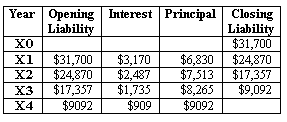- CFA Exams
- 2026 Level I
- Topic 4. Financial Statement Analysis
- Learning Module 8. Topics in Long-Term Liabilities and Equity
- Subject 3. Accounting and Reporting by the Lessee
Why should I choose AnalystNotes?
Simply put: AnalystNotes offers the best value and the best product available to help you pass your exams.
Subject 3. Accounting and Reporting by the Lessee PDF Download
Suppose a non-cancelable lease begins on Dec. 31, 20X0 with annual lease payments of $10,000 made at the end of each year for four years. Ten percent is assumed to be the appropriate discount rate.
Operating Lease (OL) for a Lessee
- No entry is made at the inception of the lease.
- Over the life of the lease, only the annual rental expense (an operating expense) of $10,000 will be charged to income and CFO.
Capital/Finance Lease (CL) for a Lessee
- At the inception of the lease, an asset (leasehold asset) and liability (leasehold liability) equal to the present value of the lease payments, $31,700, is recognized. The implicit interest rate of the lease is the discount rate that sets the aggregate present value of lease payments to be equal to the fair market value of the leased asset.
- Over the life of the lease:
- The annual rental expense of $10,000 will be allocated between interest and principal payments on the $31,700 leasehold liability according to the amortization schedule.
- Interest payment = Beginning lease obligation x implicit discount rate. It is accounted for as interest expense, which reduces income and cash flow from operating activities.
- Principal repayment = Lease payment - Interest payment. It reduces lease liability and cash flows from financing activities. It has no effect on the income statement.
- Ending lease obligation = Beginning lease obligation - principal repayment
- The $31,700 cost of the leasehold asset is charged to operating expense (annual depreciation is $7,925) using the straight-line method over the term of the lease. Depreciation is charged to income but has no effect on cash flows.
- The annual rental expense of $10,000 will be allocated between interest and principal payments on the $31,700 leasehold liability according to the amortization schedule.
Amortization schedule:

Financial effects:
Balance sheet effects- When a lease is a finance lease, gross ($31,700) and net amounts are reported at each BS date. CL increases asset balances, resulting in lower asset turnover and lower ROA than OL classification.
- The current liability is the principal portion of the first lease payment. Non-current liability is the rest of the principal. At the lease's inception, leased assets and liabilities (A&L) are equal at $31,700.
- The most important effect of a CL is the impact on leverage ratios, which results in an increase in debt to equity and other leverage ratios. As lease obligations aren't recognized for OL, leverage ratios are understated.
Income statement (IS) effects
An OL charges constant rental payments to expense as accrued, whereas a CL recognizes and apportions depreciation and interest expense over the term of the lease.
Operating income:
Capitalization results in a higher EBIT, as the straight-line depreciation expense of $7,925 is lower than the OL rental expense of $10,000.
Total expense & net income:
CL interest expense falls over time and depreciation expense is constant (straight-line depreciation) or declining (accelerated depreciation method). Total expense for CL declines over the lease term. Initially, it's higher than OL expense but over time it becomes lower. Tax expense and net income for an OL are constant over time. Tax expense and net income for a CL increase; for a CL, one also reports an accumulating deferred tax expense.
Compared to a CL, firms using an OL generally report higher profits, interest coverage, and ROA. Lease expense (for CL=$11,095) exceeds lease payments (for OL=$10,000), so there will be a deferred tax credit. The deferred tax amount increases until the lease expense is less than the lease payments, and then the account declines and is eliminated by the end of the lease.
No deferred tax is reported for OL, since the amount deductible for taxes and reported lease expense are always the same. Total (interest and depreciation) expense for a CL must equal total rental expense for an OL, over the life of the lease. Net income is not affected by CL but CL reports lower income earlier in the lease term and higher income later.
Cash flows effects
Under an OL, all cash flows are operating and there is an operating cash outflow of $10,000 per year. Annual payments of $10,000 create a tax benefit of $3,500 per year, which is deductible regardless of the lease method used. CL produces operating cash flows (CFO) and financial cash flows (FCF). The $10,000 paid under the CL is allocated between interest and amortization of the lease obligation (reported as cash from financing).
For a CL, as interest expense declines over the term of lease and an increasing portion is allocated to the lease obligation, the difference in CFO increases over the lease. CL therefore decreases operating cash outflow while increasing financing cash outflow.
Note that under IFRS the interest expense portion of the lease payment can be treated as either operating or financing cash outflow, but under U.S. GAAP it is treated as operating cash outflow.
Summary (For a Lessee):

User Contributed Comments 5
| User | Comment |
|---|---|
| papajeff | well, that's totally clear....and now forgotten. |
| Diruuk | lol |
| Sheeb | Amen brother. |
| Ewan2015 | Don't worry it changes in a year anyway and the differences will become negligible between the two. |
| sdm1981 | For operating leases. If the lessor holds the asset do they also depreciate it on their BS? I know they record the revenue earned from the lease |

I used your notes and passed ... highly recommended!

Lauren
My Own Flashcard
No flashcard found. Add a private flashcard for the subject.
Add